A Study Done in Karve road, Pune, India Comparing Effectiveness of the Existing Mode of Malaria, Dengue Fever and Chikungunya Surveillance with a new System - Community Disease Detection and Response Network, (CODREN) System
Mr. Gregory Sakwa, Mr. Alex Chebor
Abstract
Introduction: World Health Organization (WHO) defines disease surveillance as continuous, systematic
collection, analysis and interpretation of health-related data needed for the planning, implementation, and
evaluation of public health practice. Its aims are to serve as an early warning system for impending public health
emergencies, document the impact of an intervention, or track progress towards specified goals and monitor and
clarify the epidemiology of health problems, to allow priorities to be set and to inform public health policy and
strategies (WHO, 2016). The need for disease surveillance networking in India arose from the challenges
encountered in the year 2009 when Pune city experienced the major effect of H1N1 pandemic (Ministry of Health
and Family Welfare, [MHFW] 2009). A large proportion of the population was affected. The situation was made
worse by a lack of prepared public health surveillance system, unregulated private health sector and a large
urban population whose health demands exceeded the available health care (N Prasad, M Mithilesh and G Rao,
2010). Usually, surveillance activities in the ward are done by malaria surveillance inspector from Pune
Municipal Corporation, (PMC). The team performs active surveillance by visiting a few designated diagnostic
laboratories and hospitals regularly to collect data on laboratory confirmed cases of Vector Borne Diseases,
(VBD). Any confirmed case activates standard response from PMC (also referred to malaria officer in the study).
By this approach, not all diagnostic laboratories and hospitals in the area are visited, nor are all cases reported.
Similarly, suspected cases are neither reported nor followed up. The private sector which constitutes more than
85% of the urban health resources is not involved in disease surveillance. A network, Community Disease
detection and Response Network, CODREN, was developed as a tool for collecting surveillance data.This study
therefore used CODREN in Karve road ward office area, Pune, India, as a supplement to the existing disease
surveillance network system administered by PMC through Malaria Officer while determining its effectiveness.
Objective: To determine the effectiveness of CODREN in Karve road ward office area, Pune, as an early disease
detection system for disease outbreaks using Malaria, Chikungunya and Dengue virus as an example.
Methodology: Design: Descriptive cross-sectional study design, Sample size: Three hundred and eighty (380)
facilities were selected conveniently to be part of the study, because they had the necessary minimum
technological facilities. One person from each of the facilities was recruited into the study. Data collection: The
selected person from each facility was to enter data on CODREN as soon as a case was detected, whether
confirmed or suspected for a period of three months beginning 1st of October to 31st of December 2012. This was
done alongside the existing surveillance system by PMC. Analysis: Resultant data was then analyzed using excel
and SPSS version 20.0 whereby descriptive statistics were considered-Frequencies and means of the CODREN
data Vis a Vis data from the already existing tool (PMC) in terms of effectiveness’ were considered. Results and
conclusions: Suspected cases of malaria, (92%) which were not captured by PMC responded to antimalarials
drugs indicating that they were missed true cases of malaria. Seven (0.12%) confirmed cases of malaria and five
cases (92%) of Chikungunya were also missed out by PMC surveillance system but captured by CODREN. This is
an indication that CODREN as a surveillance tool would significantly complement the already existing PMC
system of surveillance.
Full Text: PDF
International Journal of Humanities and Social Science
ISSN 2220-8488 (Print), 2221-0989 (Online) 10.30845/ijhssMENU
Call for Papers
The Brooklyn Research and Publishing Institute (BRPI) invites academics, scholars, researchers, and professionals from around the world to submit their manuscripts for publication in our wide range of highly esteemed peer-reviewed academic journals.
Read more...Recruitment of Reviewers
The Brooklyn Research and Publishing Institute (BRPI), a distinguished international publisher of open-access academic journals, is currently inviting qualified scholars to join its esteemed pool of peer reviewers.
Read more...
Visitors Counter
23997920
| 13346 | |
| |
6490 |
| |
13346 |
| |
369552 |
| 23997920 | |
| 96 |
